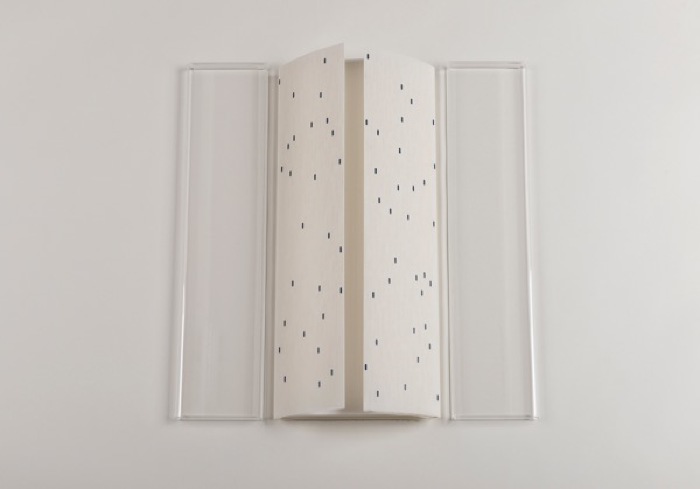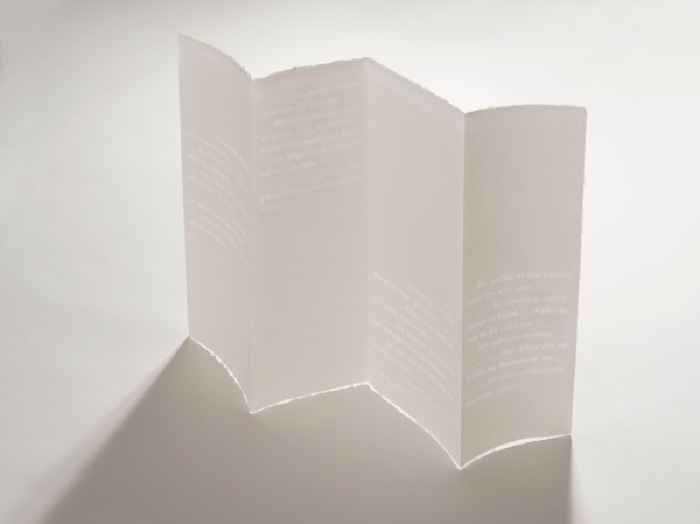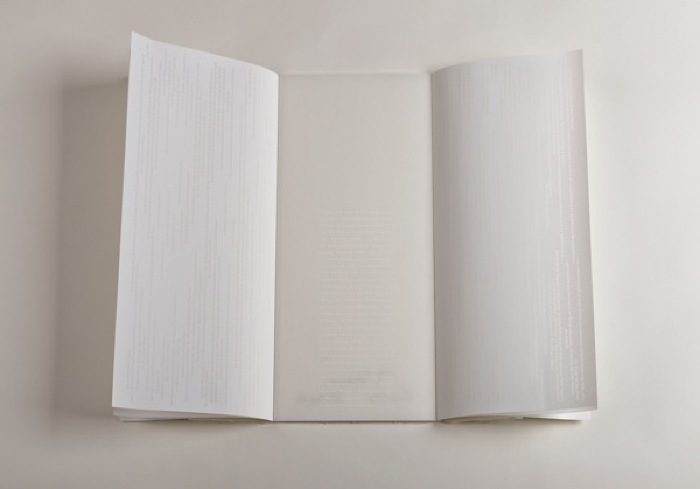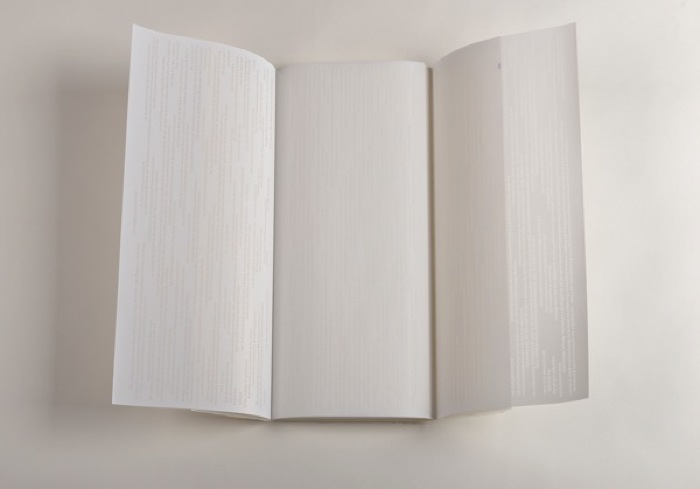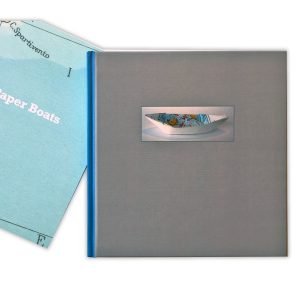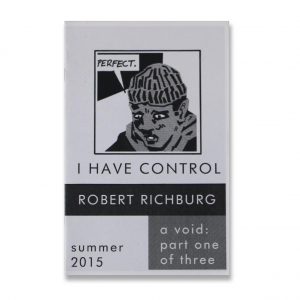White Verbs
White Verbs
Date
2017
Edition Size
46
Media
Letterpress
Binding
Hand-sewn, Loose pages, Pamphlet
Format
Artist Book
Dimensions
16 × 6.25 in
Location
Karlsruhe, Baden-Württemberg, Germany
$ 2,200.00
Unavailable
View Collectors
Athenaeum Music & Arts Library, La Jolla
Franklin and Marshall College
Stanford University
University of Arizona Library
University of California, Los Angeles (UCLA), William Andrews Clark Library
University of Southern California (USC)
“Years ago, I encountered Malevich’s painting ‘White on White’ in New York – the last, most consistent piece in his series of squares. With perfect logic, my first reaction was a smile. In order to emphasize its contrast with the white background, the White Square was slightly tilted. It seemed to sway a bit as if it had downed one drop of vodka too many. I was surprised to see the small brushstrokes that made up the “white.” Also, the varnish was now furrowed like the forehead of an old man. I felt sorry for the picture, with its sad craquelé and its frailty. I had imagined its effect would be like a kind of blindness, a revelation of the absolute. But that is the way of all art – the longer it ages, the more human it becomes. That was when I had the idea for “Weiße Verben” [White Verbs]. A few lines, forgotten in a notebook, lost in the intransitive – I was reminded of them now, and I completed the lines.
“Mixed into the poem are a couple of phrases and quoted fragments from the master of Suprematist painting. In one of his manifestos, he had declared war on lazy mankind:
But you, you wriggle in the nets of the horizon like fish!”
—Durs Grünbein, Berlin, 2017
Durs Grünbein’s poem “Weiße Verben” is a response to his first encounter with Kazimir Malevich’s painting “Suprematist Composition: White on White” (1918) in the New York Museum of Modern Art.
Expecting to experience a revelation upon seeing the icon of modern painting, he instead describes his first reaction as a smile, which is quickly replaced by a sense of disappointment.
Nearly a hundred years old, the picture has lost much of the incredible impact that it had at the time of its creation in 1918, when Malevich completed his series of squares and founded the Suprematist movement.
In the commentary accompanying the poem, Grünbein describes the aging process that is revealed in the craquelé of the varnish, along with the small brushstrokes that render the painting process visible; in his perception, the picture becomes humanized by its obvious aging and seems almost pitiful.
Under the influence of this encounter, Grünbein notes down verbs that he associates with the color “white,” which are later used to create the poem. The verbs describe processes of dissolution and transience; he contrasts them with individual “quoted fragments” from Malevich’s numerous manifestos.
The image of vanishing, and the important role that the oil painting’s materiality plays in its visible aging process, inspired me to execute the poem as a watermark. It looks ghostly on the white mould-made paper, and only becomes visible and legible when the page is held up to the light. The individual lines are unconnected to Grünbein’s line breaks, and each stanza forms a square – the only formal reference to Malevich’s painting.
The white page is contrasted with a colored graphic element, which presents the poem using a graphemic color code developed by the synesthete Eva-Maria Bolz. Each line of color stands for one letter in the text. In the few instances where she perceives a term lexically, the whole word appears in the same color.
While for Malevich “White on White” was an expression of pure abstraction and for Grünbein the “White Verbs” are a metaphor for the inevitable aging process, Eva-Maria Bolz cannot read a text without associating the individual letters and words with colors. Because of her synesthesia, traditional European color symbolism is lost on her.
The synesthetic color translation, printed on thick Japan paper, and the watermarked manila hemp paper are placed on either side of a sturdy, folded transparent cover that bears the imprint and/or Grünbein’s comments about his poem.
Each of these two sheets is covered by 10 pages, which are printed with excerpts from Malevich’s manifestos “The Artist” and “Contemporary Art.” They show how revolutionary Malevich’s ideas were at the time, and how strongly they were influenced by the technical and political upheavals and changes in Russia. The manifesto is screen printed as a negative white text on transparent paper; like the watermark, it is most easily read by holding it up to the light or placing a dark page underneath it. The text layout is based on Strichtarn, a camouflage pattern used in the first half of the 20th century, and refers to a line from Grünbein’s poem:
Sie operieren verdeckt” (they operate under cover).
It is quite a challenge for the reader to page through the manifesto and read it. The typography, with its offset lines and the negative printing, illustrates Malevich’s thought processes; his writing is erratic and dogmatic, and his ideas and visions come out in a rush. The book jacket consists of two layers of paper – a thick transparent cover and a hand-moulded abaca paper. Both are subtly printed with the Strichtarn pattern. There is no front or back to the book; they are identical and equivalent. Mere chance determines whether the reader will discover the watermark with the poem first, or the graphic with the synesthetic color code.
Concept, design, printing and binding: Veronika Schäpers.
Poem, “Weiße Verben” (White Verbs): Durs Grünbein,
moulded as a watermark in manila hemp paper by Gangolf Ulbricht.
Synesthetic realization of the poem: Eva-Maria Bolz, using her own color code. Inkjet printed on Inbe Thick from Awagami.
Excerpts from the manifestos of Kazimir Malevich,
from: Kazimir Malevich / Gott ist nicht gestürzt! [God is Not Cast Down]
translated by Thomas Kleinbub and Aage A. Hansen-Löve, Carl Hanser Verlag, 2004. Negative screen print on EnDuro Ice.
Letterpressed cover of EnDuro Ice and hand-moulded abaca paper with Strichtarn pattern.
2-piece acrylic box with title.
16 x 40.5 cm.
Edition: 40 copies with Arabic numbering and 6 copies with Roman numbering.
Karlsruhe, December 2017.
White Verbs
The white verbs are all invisible.
They circle around activities that are not learned.
They are disappear, extinguish, perish
they lead to deserted territory.
They creep through the room unnoticedThey are disintegrate, scatter. Their
Ghostly hand crosses out anything that once existed.
They wrap our thinking in snowfall, a fog, And start as a line of chalk on the blackboard.
They give language its sense of finality.
To snow is one of these verbs, to freeze
To age is another, to despair, to pass away.
They can cut through the knot of wisdom.
They are a traveling blind spot.
They are at the edges of every psyche.
The white verbs hardly make a stir.
They are thorough, they can be relied upon. They exist as love exists.
They operate in secret
And silently advance under cover of the main words.
They aim at horizons that nothing can reach.

